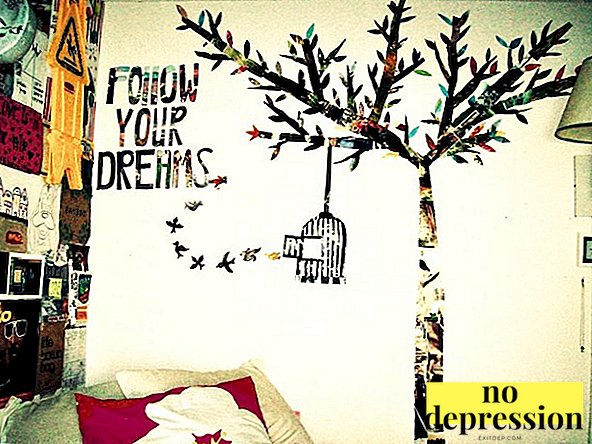A person experiences many different emotions, both positive and negative.
It is on them that emotional therapy is directed - it helps relieve tension and understand your feelings.
Nikolay Linde

Emotional therapy - This direction in psychotherapy, which appeared thanks to Nikolai Linda.
It is based on work with images, which allows you to influence the emotional and psychological state of a person.
In developing his therapy, Linde based on many known areas of psychologyamong which is gestalt therapy, psychoanalysis, NLP and others.
The idea of this method is that any problem in a person arises from the fact that his emotional energy is directed at a specific goal. To understand the cause of the problem and to understand its cause, images help.
The main task of such therapy is to find the original cause of the psychological problem.
After it is possible to resolve the conflict at a deep level, all other psychological problems that have arisen on its basis gradually disappear.
Emotional therapy is effective in the following cases.:
- deliverance from anxiety and phobias;
- getting rid of allergies, asthma, breathing problems;
- treatment of neurodermatitis;
- elimination of psychogenic pains;
- and other diseases that are based on the psychological problems of the person.
Exercises

Consider a series of exercises that are used in emotional and imaginative therapy:
- "Who am I?" Take a comfortable position, close your eyes and silently pronounce the question: "who am I?". At the same time you need to follow the emerging images and thoughts. There may be a lot of answers and all of them should be analyzed later.
- "Inner space." Imagine that you work as a tuner of your body's organs. You have a magic capsule (best of all, if it is golden and oval, but you can choose any color and shape), in which you move from one organ to another and, checking your sensations, correct something that does not work correctly .
You clean, relax and improve the work of your organs, using any suitable tools.
- "Washing with energies." Imagine that your body is being washed with various positive energies. First, the energy of light, which penetrates even the darkest parts of your body and illuminates them. Then the energy of the air, which the wind enters your body and cleans out all the dust and dirt. After that, the energy of water appears, which washes away all that remains after such a cleaning.
 Next, imagine the energy of fire (it should be a white or blue fire that does not burn you), which will burn the last dirt in your body. After that, with the help of the energy of the metal, you will wash everything that is heavy from your body. And finally, you need to imagine that you fill yourself from the inside with blue or white powder.
Next, imagine the energy of fire (it should be a white or blue fire that does not burn you), which will burn the last dirt in your body. After that, with the help of the energy of the metal, you will wash everything that is heavy from your body. And finally, you need to imagine that you fill yourself from the inside with blue or white powder. - "Radiation of kindness." Imagine a luminous point in front of you that radiates goodness. Then mentally move yourself or this image so that the point is in the center of you. Imagine that this energy of kindness begins to fill your body, and then goes beyond it.
Feel yourself as a source of kindness and listen to the feelings that you currently have.
A.Ellisa
Rational-emotional therapy created by Albert Ellis. Its main goal is to educate the person rational sociality. That is, in fact, it is not psychotherapy or treatment, but training aimed at changing behavior.

Through such training, a person learns to cope with his emotions, feelings and experiences, as well as life problems that arise in his way.
In addition, she teaches the individual basics of rational thinking and behavior.
At the heart of rational-emotional therapy lies the theory that all human problems arise from irrational beliefsunder which they understand faith in "I must," "I need," and "I should." If they are fixed, the problem will be resolved.
According to the theory of A. Ellis, a person, facing a situation, interprets it on the basis of his deep-rooted beliefs, and builds his behavior in accordance with this interpretation.
Thus, rational-emotional therapy is based on working with the beliefs of the individual. There are three basic principles.:
- People do not have problems because of what is happening to them, but because of how they perceive them based on their beliefs.
- It does not matter when an individual has a belief. If he still has certain problems, it means that he is still holding that belief.
- If a person wants to solve his problem, he need to constantly work above it and throughout your life practice. Otherwise, therapy will lose its meaning.
Rational-emotional psychotherapy - how it works:
Stages of work
To work with established beliefs of the individual, use the following steps:
- Analysis and diagnosis. Before beliefs are eliminated, they must be discovered and recognized.
- Softening. In order to convince convictions, use the method of critical discussion. It is based on the fact that all the beliefs of the individual exist because of this or that justification. Therefore, when a person begins to become aware of his beliefs and pathogenic thoughts, then for each of them he needs to answer the question: “Why is this thought true?”
- Replacing irrational beliefs with more flexible and rational.
It is impossible to completely abandon beliefs - they must be replaced with the right ones. Such work is much more effective.
- Introduce new beliefs as a habit. Based on regular training for a long time. At this stage it is necessary to keep track so that old beliefs will not reappear. You should also actively work with new rational beliefs.
- Learning to do all this work yourself. This stage is related to teaching a person to be a therapist for himself. But you can go to it only when the individual feels that he is able to cope with the problems on his own and is confident that he will be able to deal with any future difficulties on his own.

All listed steps are performed. with the help of the developed blank forms and special exercises. The man basically does them on his own, doing his homework and keeping a diary. Sessions are also held with a consultant who checks the work done by the individual, corrects mistakes and helps to develop new beliefs.

Leslie Greenberg and Susan Johnson
Emotionally focused therapy developed by Leslie Greenberg and Susan Johnson as a method for helping couples.
It is based on the fact that in organizing interaction in a pair, emotional processes are of particular importance.
According to studies, thanks to this therapy, about 70% of couples cope with the crisis in their relationship. Besides, 90% of couples notice significant improvements. in interaction with each other.
Emotionally focused therapy allows:
- reduce anxiety of spouses, get rid of depression;
- improve various aspects of their relationship;
- feel confidence and security in your pair;
- experience greater intimacy and intimacy with your partner;
- significantly reduce the power of conflict.

The main task of emotionally focused therapy is to building affection in a pairwhich is expressed in the emotional involvement and responsiveness of partners coming from both sides.
Principles of therapy
In this therapeutic process, the following steps are distinguished:
- Identify duplicate chains of interaction between spouses around problem topics, the main triggers of a conflict situation. Also at this stage, the typical behavior of partners, leading to increased conflict, is traced.
The task of the therapist is to identify the main goal of the work and help partners understand their feelings.
As a rule, the outcome of this stage is to alleviate the crisis and reduce the intensity of the conflict. Partners understand and accept each other better.
- Work with the stereotypes of the response of partners in conflict. In any relationship it is impossible to completely avoid controversy and conflict. But you can learn to solve the emerging contradictions. The task of the therapist is to teach the spouses to safely express their emotions. In addition, it helps partners develop a need for intimacy. Due to this, emotional security arises between them, they weaken their defensive positions and are able to react more calmly when a conflict situation arises.
Thanks to the new emotional experience of the spouses, they have more hope for a positive outcome of the therapy, and there is also confidence in the relationship between them at the emotional level.
- Summarizing the therapy and experience gained. Partners have learned new ways of responding that they can use in a conflict situation. They help them to solve many critical moments and questions that previously immediately led to a quarrel. Each partner has formed a more positive image of the spouse. They also have a much clearer affection and respect. Due to this, any interaction is much easier, even if it concerns critical moments. Disagreements no longer lead to anxiety, they are resolved immediately and at a rational level.


Emotionally focused therapy is necessary for those couples who want to work on their relationships, get closer understand each other better.
As a result of the therapy, the spouses begin to feel that their relationship has changed.
Now everyone sees positive interaction and the desire to work on their relationships.
Spouses notice that their relationship becomes more pleasant, close and trusting. Each spouse is determined to better understand the feelings of the other, and not to build barriers and protect his feelings.
Emotional Therapy - quite a popular trend in psychology. Considered directions for several decades have proven their effectiveness.

 Next, imagine the energy of fire (it should be a white or blue fire that does not burn you), which will burn the last dirt in your body. After that, with the help of the energy of the metal, you will wash everything that is heavy from your body. And finally, you need to imagine that you fill yourself from the inside with blue or white powder.
Next, imagine the energy of fire (it should be a white or blue fire that does not burn you), which will burn the last dirt in your body. After that, with the help of the energy of the metal, you will wash everything that is heavy from your body. And finally, you need to imagine that you fill yourself from the inside with blue or white powder.

